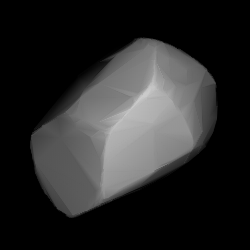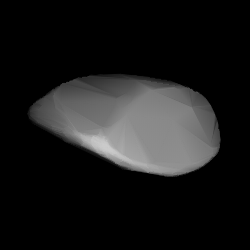
1743 Schmidt, provisional designation 4109 P-L, is a dark background asteroid from the inner regions of the asteroid belt, approximately 19 kilometers in diameter. It was discovered during the Palomar–Leiden survey on 24 September 1960, by astronomers Ingrid and Cornelis van Houten at Leiden, on photographic plates taken by Tom Gehrels at Palomar Observatory in California. The C-type asteroid has a rotation period of 17.5 hours. It was named for the optician Bernhard Schmidt.
1575 Winifred, provisional designation 1950 HH, is a stony Phocaea asteroid and slow rotator from the inner regions of the asteroid belt, approximately 9.5 kilometers in diameter.
1043 Beate, provisional designation 1925 HB, is a stony asteroid from the outer region of the asteroid belt, approximately 32 kilometers in diameter. It was discovered by German astronomer Karl Reinmuth at the Heidelberg-Königstuhl State Observatory on 22 April 1925. Any reference of its name to a person is unknown.
1477 Bonsdorffia, provisional designation 1938 CC, is a background asteroid from the outer regions of the asteroid belt, approximately 29 kilometers in diameter. It was discovered on 6 February 1938, by astronomer Yrjö Väisälä at the Iso-Heikkilä Observatory in Turku, Finland. The asteroid was named after Finnish astronomer Ilmari Bonsdorff, who founded the Finnish Geodetic Institute.

1275 Cimbria is a Eunomia asteroid from the central regions of the asteroid belt, approximately 27 kilometers in diameter. It was discovered on 30 November 1932, by astronomer Karl Reinmuth at the Heidelberg-Königstuhl State Observatory in southern Germany. The asteroid was named after the Cimbri, an ancient Germanic tribe.
1650 Heckmann, provisional designation 1937 TG, is a rare-type Nysian asteroid from the inner regions of the asteroid belt, approximately 29 kilometers in diameter. It was discovered on 11 October 1937, by German astronomer Karl Reinmuth at Heidelberg Observatory in southern Germany, and later named after astronomer Otto Heckmann.

1985 Hopmann is a dark background asteroid in the outer regions of the asteroid belt. It was discovered on 13 January 1929, by astronomer Karl Reinmuth at Landessternwarte Heidelberg-Königstuhl in southern Germany. The asteroid has a rotation period of 17.5 hours and measures approximately 36 kilometers in diameter. It was later named after German astronomer Josef Hopmann (1890–1975).
1409 Isko, provisional designation 1937 AK, is a carbonaceous background asteroid from the central regions of the asteroid belt, approximately 35 kilometers in diameter. It was discovered on 8 January 1937, by astronomer Karl Reinmuth at the Heidelberg-Königstuhl State Observatory in southwest Germany. The asteroid was named after Ise Koch, wife of astronomer Fritz Kubach.
17683 Kanagawa (provisional designation 1997 AR16) is a carbonaceous background asteroid from the outer region of the asteroid belt, approximately 22 kilometers (14 miles) in diameter. It was discovered on 10 January 1997, by Japanese astronomer Atsuo Asami at the Hadano Observatory, located 60 kilometers southwest of Tokyo, Japan. The asteroid was later named after the Japanese Kanagawa Prefecture.
1817 Katanga, provisional designation 1939 MB, is a stony Phocaea asteroid in from the inner regions of the asteroid belt, approximately 16 kilometers in diameter. It was discovered on 20 June 1939, by English-born South African astronomer Cyril Jackson at Johannesburg Observatory in South Africa. It is named for the Katanga Province.
1298 Nocturna, provisional designation 1934 AE, is a dark asteroid from the outer regions of the asteroid belt, approximately 40 kilometers in diameter. It was discovered on 7 January 1934, by German astronomer Karl Reinmuth at the Heidelberg Observatory in southwest Germany. The asteroid's name is the Feminine adjective of nocturnus, "nightly".
1760 Sandra, provisional designation 1950 GB, is a carbonaceous asteroid from the outer regions of the asteroid belt, approximately 35 kilometers in diameter. It was discovered on 10 April 1950, by South African astronomer Ernest Johnson at Union Observatory in Johannesburg, and named after his granddaughter Sandra.

1940 Whipple is a carbonaceous background asteroid from the outer region of the asteroid belt, approximately 35 kilometers in diameter. It was discovered on 2 February 1975, by the Harvard College Observatory at its George R. Agassiz Station near Harvard, Massachusetts, in the United States, and named after astronomer Fred Whipple.

1336 Zeelandia, provisional designation 1934 RW, is a stony Koronian asteroid from the outer regions of the asteroid belt, approximately 21 kilometers in diameter. It was discovered on 9 September 1934, by Dutch astronomer Hendrik van Gent at the Union Observatory in Johannesburg, South Africa. The asteroid was named for the Dutch province of Zeeland.
1461 Jean-Jacques, provisional designation 1937 YL, is a metallic asteroid from the outer region of the asteroid belt, approximately 34 kilometers in diameter. It was discovered on 30 December 1937, by French astronomer Marguerite Laugier at Nice Observatory in southern France, who named it after her son Jean-Jacques Laugier.
1558 Järnefelt, provisional designation 1942 BD, is a carbonaceous asteroid from the outer region of the asteroid belt, approximately 65 kilometers in diameter.

1719 Jens is a background asteroid from the central region of the asteroid belt, approximately 19 kilometers in diameter. It was discovered on 17 February 1950, by German astronomer Karl Reinmuth at Heidelberg Observatory in southern Germany. It was named after a grandson of the discoverer.

1407 Lindelöf, provisional designation 1936 WC, is an asteroid from the central region of the asteroid belt, approximately 20 kilometers in diameter. It was discovered on 21 November 1936, by Finnish astronomer Yrjö Väisälä at Turku Observatory in Southwest Finland. The asteroid was named after Finnish topologist Ernst Lindelöf.
1544 Vinterhansenia, provisional designation 1941 UK, is a dark asteroid from the inner regions of the asteroid belt, approximately 22 kilometers in diameter. It was discovered on 15 October 1941, by Finnish astronomer Liisi Oterma at Turku Observatory in Southwest Finland, and named for Danish astronomer Julie Vinter Hansen.

1545 Thernöe is an elongated background asteroid from the central region of the asteroid belt. It was discovered on 15 October 1941, by Finnish astronomer Liisi Oterma at Turku Observatory in Southwest Finland. The uncommon K-type asteroid has a rotation period of 16.1 hours and measures approximately 18 kilometers in diameter. It was later named after Danish astronomer Karl August Thernöe.








